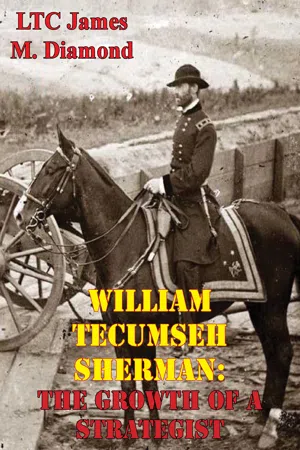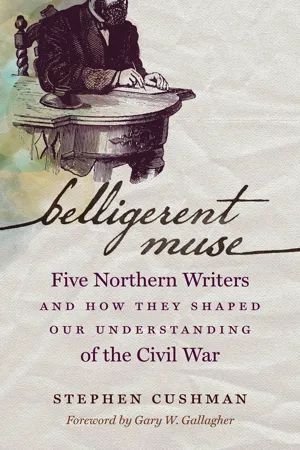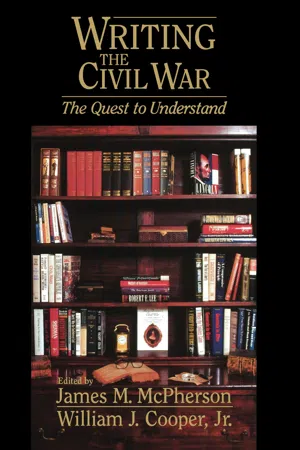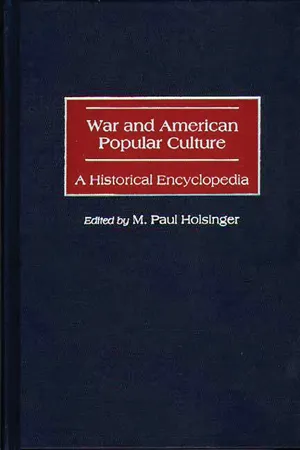History
General Sherman
General William Tecumseh Sherman was a prominent Union general during the American Civil War. He is best known for his "March to the Sea," a military campaign that involved devastating the Confederate heartland by destroying infrastructure and resources. This strategy, known as total war, aimed to break the South's will to fight and played a significant role in the Union's victory.
Written by Perlego with AI-assistance
Related key terms
1 of 5
9 Key excerpts on "General Sherman"
- eBook - ePub
On War and Leadership
The Words of Combat Commanders from Frederick the Great to Norman Schwarzkopf
- Michael Owen Connelly(Author)
- 2009(Publication Date)
- Princeton University Press(Publisher)
II William Tecumseh Sherman (1820–1891) UNION GENERALS William T. Sherman and Ulysses S. Grant set patterns for the mass warfare of the twentieth century. Moreover, their campaigns, combining the destruction of the enemy homeland and mass assault into it, are still at the heart of what Weigley calls “the American Way of War.” 1 In 1864–65,Sherman burned Atlanta and marched to the sea at Savannah, then north through the Carolinas, destroying the material base of the Southern armies and the morale of Southern troops and civilians. Grant, in the East, and Sherman in the West and South, forced the Rebels to build fortifications and use trenches and barbed wire to offset Yankee numbers and firepower. Union troops, in turn, took to trenches as well. Grant and Sherman left a legacy of trench warfare. That, conscription, and the Prussian general staff system 2 would all be used by both sides in the Great War (1914–18), and account for its horrors. Sherman especially, assailing the South with masses of men and superior weapons, did what bombing and the Soviet and Western invasions of Germany would do for the Allies in World War II—and for the United States in lesser wars since. Sherman is included here because he was the more intellectual of the leading Northern commanders, and had more to say about generalship in his Memoirs (cited below). He is remembered for his “War is Hell,” which he meant in all senses. But for him, although it is rarely mentioned, it was Hell because his heart was with the South, while his head was against destroying the Union. His devastation of the South was meant to end the war quickly—and did - Paul Finkelman, Donald R. Kennon, Paul Finkelman, Donald R. Kennon(Authors)
- 2019(Publication Date)
- Ohio University Press(Publisher)
An Infamous Disregard? 55 Georgia and the Carolinas (fgs. 1–4) during the fnal months of the Civil War have something to do with the creation of total war, and that the mil- lions of civilian deaths in the wars of the twentieth and twenty-frst centu- ries can be somehow laid at his feet. Nor does this view reside entirely on the internet, noted repository of crackpot theories. A history of Henry County, Georgia, explains simply that “Sherman’s March to the Sea was the frst hint of the concept of ‘Total War,’ which was to come to full fruition during the Second World War, in which civilian infrastructure is considered a legitimate military target.” 2 Later writers, notably James Reston Jr., tried to connect the March to atrocities in Vietnam, arguing that “when a rash Confederate ventured a shot on his trains from a courthouse, the courthouse was burned. When a lady burned her corncrib, she lost her house. The ‘proportionality’ of the retaliation is roughly the same, if geometrically less, as hostile fre from a jungle rife be- ing greeted by a B-52 strike.” 3 More recently, the writer Matthew Carr has used Sherman in a slightly more subtle fashion as the central fgure in his “antimilitarist military his- tory,” Sherman’s Ghosts: Soldiers, Civilians, and the American Way of War . While conceding the obvious point that there are vast diferences between nine- teenth and twenty-frst-century warfare, Carr nevertheless argues that Sher- man “embodies a very specifc use of military force as an instrument of coercion and intimidation that has often been replayed by the U.S. Mili- tary and also by other armies.” 4 In this case, the evils of mass warfare are not entirely Sherman’s, but he still bears considerable responsibility, even if at times only symbolically. Not that most writers even defne what they mean by total war or laws of war . Often Sherman seems to be judged by the standards of today rather than those of his own time.- eBook - ePub
Wars within a War
Controversy and Conflict over the American Civil War
- Joan Waugh, Gary W. Gallagher, Joan Waugh, Gary W. Gallagher(Authors)
- 2009(Publication Date)
- The University of North Carolina Press(Publisher)
William T. Sherman in Postwar Georgia’s Collective Memory, 1864-1914 CAROL REARDONIn February 1891, shortly after the death of William Tecumseh Sherman, a Georgia journalist posited an intriguing question: “How shall we judge a man who was one day all fire, and the next day all ice: forgiving one moment, and relentless the next, a patriot today and a partisan tomorrow?”1 This query suggests that, after the passage of nearly thirty years, Georgians’ collective memory of the famed Union general could provoke surprisingly reflective consideration. Indeed, by the time of the Civil War’s golden anniversary, Sherman’s place in Georgia’s past did not rest solely on bitter recollections of the military events of 1864. Through the years, the political and social crises of Reconstruction, the blossoming of both the Lost Cause and the New South mentalities, and the rise of Jim Crow had spawned a surprising diversity in the ways in which Georgians remembered him.From the time the Union army launched its offensive from Chattanooga in May 1864 until it marched into South Carolina in January 1865, many Georgians experienced sociologist Arthur G. Neal’s three “ingredients” of trauma: “some form of bafflement, some level of suffering, and perceptions of evil in human affairs.”2 Thousands in the direct path of the Union army experienced the near-total collapse of the familiar rhythms of their daily lives, confronting confusion, insecurity, and loss first as individuals and families and then as citizens of a larger political entity. To make sense of the chaos breaking around them, Georgians demanded to know what happened and, even more importantly, why it had happened.During the 1864 campaign, few Georgians truly comprehended what had happened to their state. Newspapers and the telegraph system brought only incomplete and contradictory assessments of fast-breaking events that might provide context for an individual’s or family’s own experiences—or contradict them entirely. In a single issue of a Georgia newspaper during Sherman’s March to the Sea, for instance, readers could find detailed, block-by-block lists of destroyed buildings in Atlanta and, a few columns away, find confident boasts that loyal citizens most certainly would take up arms to defeat Sherman before he could ever wreak any such havoc. Reports of outrages against women and children attributed to Sherman’s “bummers” appeared in the same issue as stories of unexpected benevolence extended by the northern invaders. Georgians read of faithful slaves saving their masters’ lives and property and of other slaves willingly pointing out to Yankee soldiers the caches of food and valuables their masters had hidden.3 - Lieutenant-General John Schofield(Author)
- 2015(Publication Date)
- Golden Springs Publishing(Publisher)
In connection with Sherman’s operations it is essential to bear in mind the distinction between two radically different kinds of strategy, one of which has for its object the conquest of territory or the capture of places by defeating in battle or out-manoeuvering the defending armies; while the other has for its object the destruction or capture of those armies, resulting, of course, in the conquest of all the enemy’s territory. The first kind may be all-sufficient, and hence best, in a foreign war having for its object anything less than total conquest; but in the suppression of a rebellion, as in a foreign conquest, the occupation of places or territory ought to be entirely ignored except so far as this contributes to the successful operation of armies against opposing forces. This fundamental principle appears to have been duly appreciated by the leading Union commanders near the close of the Civil War, though not so fully in its earlier stages. Military critics are apt to fall into error by not understanding the principle itself, or by overlooking the change of policy above referred to.SHERMAN’S PURPOSE IN MARCHING TO THE SEAIt is necessary not to confound the “march to the sea” as actually conceived and executed by Sherman as a preliminary to the march northward for the capture of Lee’s army, with the previous far-reaching strategic plans of Grant, of which Sherman and other chief commanders were informed in the spring of 1864.Grant’s plans had in view, as their great object, again to cut in two the Confederate territory, as had been done by the opening of the Mississippi River to the gulf. This next line of section might be Chattanooga, Atlanta, and Savannah, or Chattanooga, Atlanta, Montgomery, and Mobile. But with the disappearance of Hood’s army from that theater of operations, all reason for that plan of “territorial” strategy had disappeared, and the occasion was then presented, for the first time, for the wholly different strategical plan of Sherman, of which Lee’s army was the sole military objective. Grant was perfectly just to himself as well as to Sherman in giving the latter full credit for this last plan; and he modestly refrained from any more than a brief mention of his own plans, which unforseen events had made it unnecessary fully to execute. But history will do justice to Grant’s great strategical designs as well as to his great achievements. I trust it may be my good fortune to contribute something hereafter toward the payment of this debt of gratitude which all Americans owe to the greatest soldier of the Union.The fact that Savannah was one of the points in both Grant’s plans and Sherman’s was merely an incident, and a very unimportant one. Indeed, after Hood got out of his way, Sherman might as well, and I think better, have marched direct to Augusta, and thence northward, wholly ignoring Savannah as well as Charleston, except that he would have arrived in Virginia rather early in the season. Savannah was a good place to go in order to spend the winter, besides destroying Georgia en route.- LTC James M. Diamond US Army(Author)
- 2015(Publication Date)
- Golden Springs Publishing(Publisher)
William Tecumseh Sherman: Growth of a Strategist
In the opening days of the American Civil War strategic thought, in the minds of many who would lead the North’s forces, could be summed up in the three stirring words “On to Richmond!”One who saw beyond that enticing but ultimately false course was William Tecumseh Sherman. How was it that Sherman, who had left the Army in 1853 and was serving as the President of the Louisiana Seminary of Learning and Military Academy as the war approached, was able to see what the senior military and political leaders of the North could not?The way Sherman perceived the coming struggle, what he thought about the ends, means, and ways with which he would labor for those four bloody, terrible years was in part based on his unique personality and in part developed over years of study, travel, and experience. Those thoughts and experiences, distilled by Sherman’s quick, trenchant intellect ultimately produced a strategic vision of ways and means to achieve the military and political ends of the Union in the Civil War.Sherman’s successful collaboration with his contemporary and commander, U. S. Grant, brought the Union victories in the field and eventually victory in the war. Sherman’s contributions to their efforts took many forms. He was a superb subordinate to Grant, aggressive in the field, quick in carrying out his orders and in accomplishing his missions. He was also able, perhaps to a greater degree than Grant, to see and understand things about this war that often escaped others.Despite his ultimate success Sherman did not appear on the field with all of the answers and all of the authority he needed to defeat the South. Indeed, he spent the first two years of the war growing, sometimes through very painful lessons, to reach his potential as a commander and strategist. But these first two years of the war were only a continuation of a lifetime of trials, growth, observation, study, and occasional failure that finally produced the Army Commander who would contribute so much to the Union victory’ in the Civil War.- eBook - PDF
Life in Dixie During the War
1861-1865
- (Author)
- 2012(Publication Date)
- The Floating Press(Publisher)
Some of them are loaded down with silverware, gold coin, and other valuables. I hazard nothing in saying three fifths (in value) of the personal property of the country we have passed through was taken by Sherman's army. In an address delivered before the Association of the Maryland Line, Senator Zeb Vance, of North Carolina, has laid the vigorous touch of his characteristic English upon the void until it stands out in barbarous bold relief, so far beyond the pencil of the present writer that he best serves his readers by quoting: With reference to his famous and infamous march, I wish to say that I hope I am too much of a man to complain of the natural and inevitable hardships, 337 or even cruelties of war; but of the manner in which this army treated the peaceful and defenseless inhabitants in the reach of his columns, all civilization should complain. There are always stragglers and desperadoes following in the wake of an army, who do some damage to and inflict some outrages upon helpless citizens, in spite of all efforts of commanding officers to restrain and punish; but when a General organizes a corps of thieves and plunderers as a part of his invading army, and licenses beforehand their outrages, he and all who countenance, aid or abet, invite the execration of mankind. This peculiar arm of military service, it is charged and believed, was instituted by General Sherman in his invasion of the Southern States. Certain it is that the operations of his 'Bummer Corps' were as regular and as unrebuked, if not as much commended for efficiency, as any other division of his army, and their atrocities are often justified or excused, on the ground that 'such is war.' In his own official report of his operations in Georgia, he says: 'We consumed the corn and fodder in the region of country thirty miles either side of a line from Atlanta to Savannah, also the sweet potatoes, hogs, sheep and poultry, and carried off more than ten thousand horses and mules. - eBook - ePub
Belligerent Muse
Five Northern Writers and How They Shaped Our Understanding of the Civil War
- Stephen Cushman(Author)
- 2014(Publication Date)
- The University of North Carolina Press(Publisher)
Sherman as an artistic achievement, is to risk overlooking the continuity between Sherman’s representation of himself in prose and the image of himself he constructed and wielded effectively as an instrument of war. During the Civil War Sherman discovered that the ways others saw him were important and powerful. In a letter to Grant dated January 29, 1865, included in the chapter “Savannah and Pocotaligo,” he closed with this candid statement: “I observe that the enemy has some respect for my name, for they gave up Pocotaligo without a fight when they heard that the attacking force belonged to my army.” Then, in a sentence anticipating the practical consequences of this fresh observation, he added, “I will try and keep up that feeling, which is a real power” (Memoirs, 741). It is instructive to compare these sentences with a passage in Grant’s Personal Memoirs (1885–86), one in which Grant narrated his leading the Twenty-first Illinois regiment against Colonel Thomas Harris at Florida, Missouri, in the summer of 1861. Having advanced against Harris’s camp and found it abandoned, Grant commented, “It occurred to me at once that Harris had been as much afraid of me as I had been of him. . . . The lesson was valuable.” 4 Grant’s revelation about the fears of an enemy occurred at the beginning of the war and served to free him from “trepidation upon confronting an enemy, though I always felt more or less anxiety”; Sherman’s revelation about the fears of an enemy occurred late in the war and served to arm him with another weapon to brandish against that enemy - eBook - PDF
Writing the Civil War
The Quest to Understand
- James M. McPherson, William J. Cooper, James M. McPherson, William J. Cooper, Jr.(Authors)
- 2021(Publication Date)
- University of South Carolina Press(Publisher)
More representative of the emerging work on soldiers was the next to appear in print, Joseph T. Glatthaar's The March to the Sea and Beyond: Sherman's Troops in the Savannah and Carolinas Campaigns (1985). All Glatthaar claimed to have done was extend Wiley's analysis of the Union soldier, which focused heavily on the Army of the Potomac, to Sherman's 84 NOT THE GENERAL BUT THE SOLDIER army. Actually, Glatthaar raised the study of the common soldier to a new level of sophistication by taking the soldier's attitudes toward the war, toward African Americans, and toward white southerners much more seriously than Wiley had. In other respects, Glatthaar stuck to Wiley's model. Like Wiley, Glatthaar paid great attention to the material circum-stances of soldiering. His chapter on camp life is very much in Wiley's vein. 8 Reenlisted veterans, men who supported Lincoln's reelection, com-posed the bulk of Sherman's army. Furthermore, because of the nature of the March, they depended on their own initiative and escaped the super-vision of senior officers to an extraordinary degree. Glatthaar shows them to have had a strong commitment to Union, a hatred for southern society, which they perceived as not only treasonous but antidemocratic as well, and a hatred of slavery as an institution-although often accompanied by prejudice against African Americans and doubts about their place in America after emancipation. Beyond ideological motivations, Glatthaar also explicates the extreme self-confidence and self-reliance of Sherman's men, arguing that no other army could have made the March. - eBook - PDF
War and American Popular Culture
A Historical Encyclopedia
- M. Paul Holsinger(Author)
- 1999(Publication Date)
- Greenwood(Publisher)
Though there were a number of other artistic in- terpretations of the ride, Read's was unquestionably the best known and most praised. See: Ford, Harvey S. "Thomas Buchanan Read and the Civil War: The Story of 'Sheridan's Ride.' " Ohio State Archeological and Historical Quarterly 56 (1947): 215-226. M. Paul Holsinger h+++++++++++++++++++++++++++++++++++++++++++++++++++++++++ "SHERMAN'S MARCH TO THE SEA" (Song). Union General W. T. Sher- man's notorious march from the ruins of burning Atlanta to the Atlantic Ocean port of Savannah, Georgia, in the fall and early winter of 1864 was hailed by Northerners as one of the truly great moments of the entire Civil War. Though Southerners were appalled at the Union forces' destructiveness, the general's telegram to President Lincoln announcing the latter city's capture seemed to everyone on both sides of the battle lines to signal the beginning of the end of a conflict that had taken too many lives. After reading about the general's great success in a newspaper smuggled into his Columbia, South Carolina, prison cell by a loyal Negro slave, Lieutenant Samuel H. M. Byers composed a poem in its honor. Another prisoner, Lieuten- ant J. C. Rockwell, set "Sherman's March to the Sea" to music (though the number was sung more often in latter years to the old Irish melody, "Rosin the Bow," to which the lyrics fit almost perfectly). The completed song was then smuggled out of the prison and taken to the Union Army, which was hurrying toward South Carolina; it quickly became popular. When Byers and Rockwell were freed after Sherman captured Columbia, they supposedly heard their res- cuers happily singing their new composition. More than 1 million copies of the sheet music were eventually sold. Though Henry Work's "Marching through Georgia" (which also dealt with the notable victory) became even more re- nowned, Sherman always claimed that he liked the Byers-Rockwell song better.
Index pages curate the most relevant extracts from our library of academic textbooks. They’ve been created using an in-house natural language model (NLM), each adding context and meaning to key research topics.

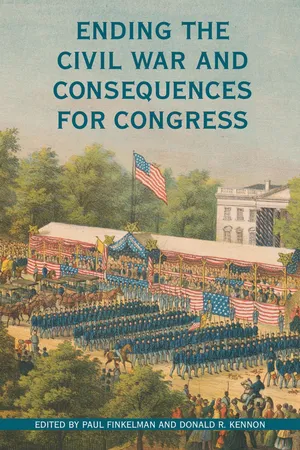
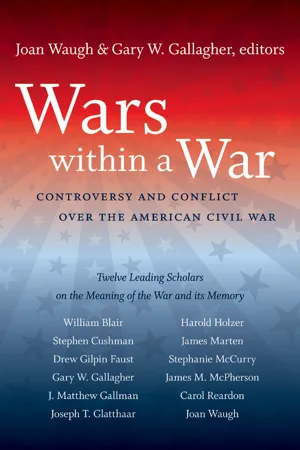
![Book cover image for: Forty-Six Years In The Army [Illustrated Edition]](https://img.perlego.com/book-covers/3020251/9781786251350_300_450.webp)
